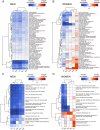Quercetin Reduces Vascular Senescence and Inflammation in Symptomatic Male but Not Female Coronary Artery Disease Patients
- PMID: 40375481
- PMCID: PMC12341813
- DOI: 10.1111/acel.70108
Quercetin Reduces Vascular Senescence and Inflammation in Symptomatic Male but Not Female Coronary Artery Disease Patients
Abstract
Recent studies suggest that vascular senescence and its associated inflammation fuel the inflammaging to favor atherogenesis; whether these pathways can be therapeutically targeted in coronary artery disease (CAD) patients remains unknown. In a randomized, double-blind trial, 97 patients (78 men) undergoing coronary artery bypass graft surgery were treated with either quercetin (500 mg twice daily, 47 patients) or placebo (50 patients) for two days pre-surgery through hospital discharge. Primary outcomes were reduced inflammation and improved endothelial function ex vivo. Exploratory analyses included plasma proteomics and single-nuclei RNA sequencing of internal thoracic artery (ITA) samples. Quercetin treatment showed a trend toward reduced C-reactive protein at discharge (p = 0.073) and differentially modulated circulating inflammatory protein expression between men and women, with a pro-inflammatory effect of quercetin in females. Endothelial acetylcholine-induced relaxation improved significantly with quercetin (p = 0.049), with effects in men (p = 0.043) but not in women (p = 0.852). ITA transcriptomics revealed the overexpression of senescence and inflammaging pathways in male vascular cells, which quercetin reversed. In female cells, quercetin had minimal endothelial benefit and increased inflammaging in fibroblasts. In male cells, a candidate target of quercetin involves interactions between the receptor PLAUR and its ligands PLAU and SERPINE1. Post-operative atrial fibrillation incidence was significantly lower with quercetin, representing 4% of the patients compared to 18% in the placebo group (p = 0.033). In conclusion, short-term quercetin treatment effectively targeted vascular senescence in male CAD patients, improving inflammatory and functional outcomes. However, these benefits were not observed in female patients. Trial Registration: https://clinicaltrials.gov, NCT04907253.
Keywords: inflammaging; cellular senescence; coronary artery disease; endothelium‐dependent relaxation; sex‐dimorphism; snRNA‐seq; systemic inflammatory proteomic.
© 2025 The Author(s). Aging Cell published by Anatomical Society and John Wiley & Sons Ltd.
Conflict of interest statement
The authors declare no conflicts of interest.
Figures





References
-
- Celermajer, D. S. , Sorensen K. E., Spiegelhalter D. J., Georgakopoulos D., Robinson J., and Deanfield J. E.. 1994. “Aging Is Associated With Endothelial Dysfunction in Healthy Men Years Before the Age‐Related Decline in Women.” Journal of the American College of Cardiology 24, no. 2: 471–476. 10.1016/0735-1097(94)90305-0. - DOI - PubMed
Publication types
MeSH terms
Substances
Associated data
Grants and funding
LinkOut - more resources
Full Text Sources
Medical
Research Materials
Miscellaneous

